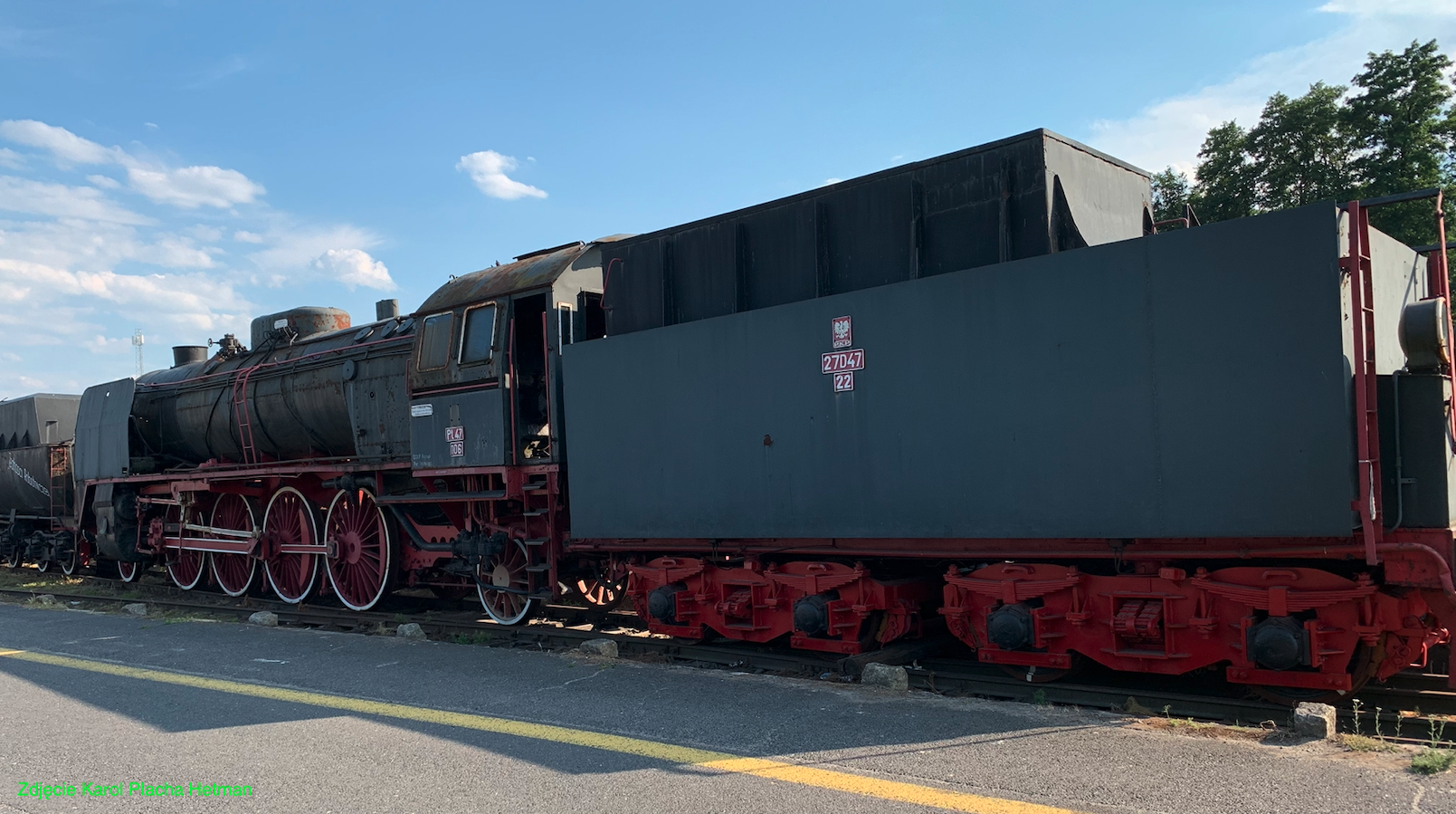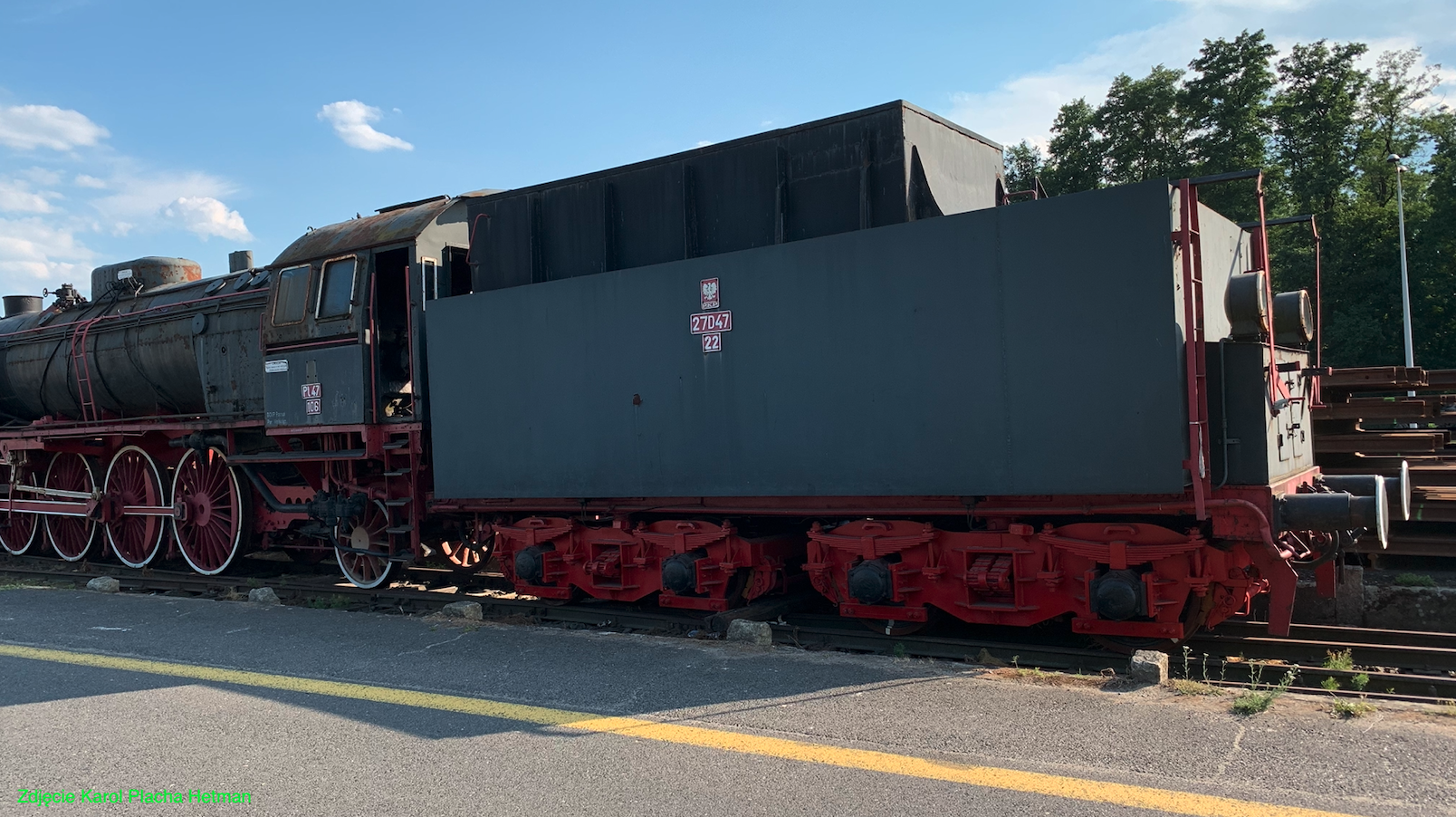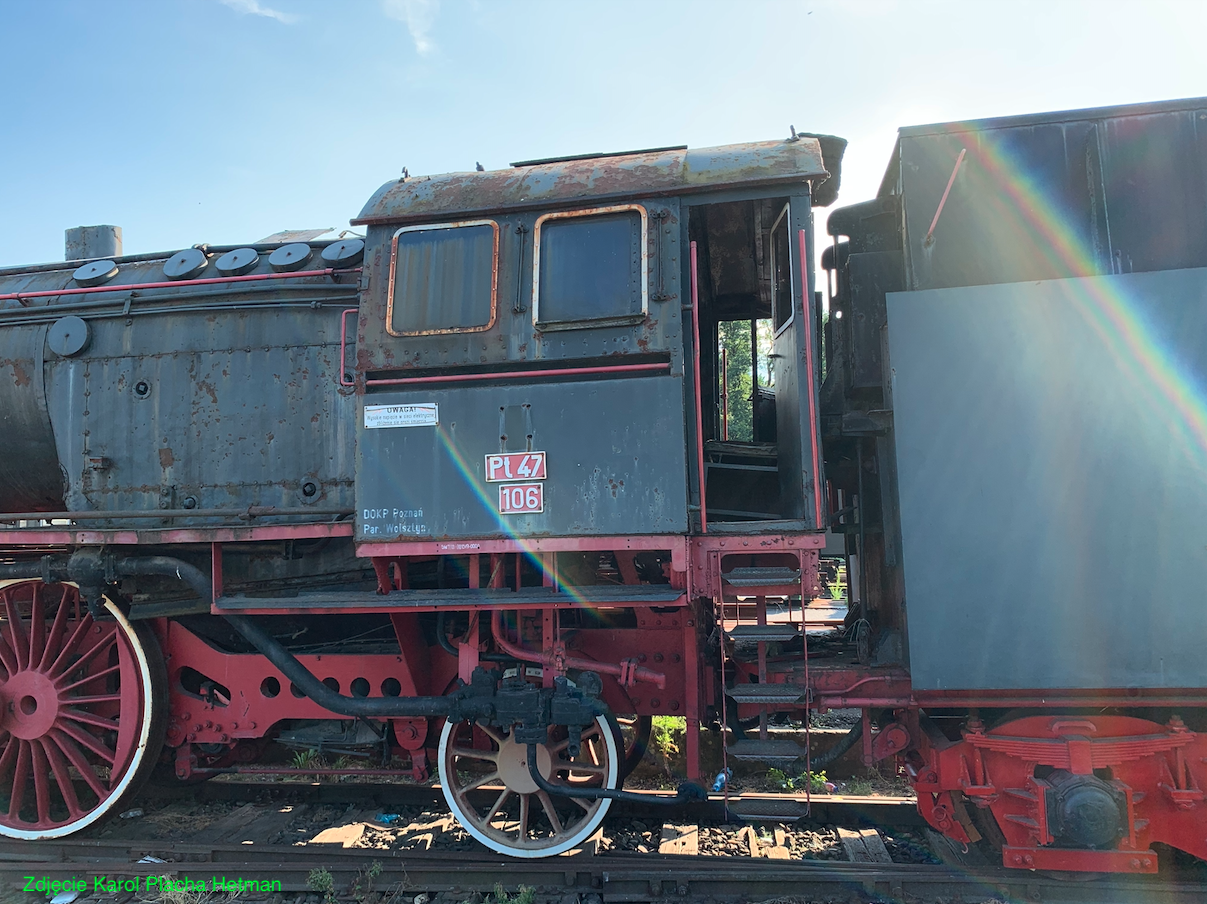Wolsztyn 2023-01-09
Fast steam locomotive Pt47-106, tender 27D47-22.
The Pt47 locomotive is a Polish fast steam locomotive, of Polish construction, produced in the period 1948-1951 for PKP. The locomotive is modeled on the Polish, pre-war locomotive Pt31. The production of Pt47 steam locomotives took place at FABLOK in Chrzanów and at HCP in Poznań. A total of 180 steam locomotives were built.



The Second World War left the railways in Poland very devastated and plundered. Germany must pay us compensation. In addition, the borders have changed. Poland lost its borderlands to the CCCP (the new occupier) and gained the so-called "Regained Territories". In addition, the return of looted rolling stock took many years. For example, the last steam locomotives were returned to us in 1955. Many of the rolling stock never returned to Poland. Especially the one that was looted by the Soviets.
Therefore, it was necessary to start the production of new rolling stock in Poland. First, it was necessary to undertake the production of freight cars and steam locomotives. In the case of steam locomotives, the extensive experience of Polish engineers was used, who designed several successful steam locomotives during the Second Polish Republic. Practically every type of steam locomotives was needed in PKP. The lack of steam locomotives for heavy long-distance passenger trains was a nuisance. In 1946, PKP had only 60 express steam locomotives, and most of them required repairs. Only 13 steam locomotives of the Pt31 series were in operation. The rest are steam locomotives from the 1920s.
Therefore, a new steam locomotive was developed based on the highly successful Pt31 locomotive. The design retained the proportions of the boiler, steam engines, and running gear. Despite this, numerous improvements and modifications have been made. They resulted from the experience gained and from the need to apply new solutions due to technological changes. Boilers supplied by the Babcock-Zieleniewski company from Sosnowiec were installed in the Pt47 locomotives.
The new locomotive was marked Pt47, which means a Pospieszny steam locomotive, with an axle system of 1'D1', and marked in Poland - a small letter "t", i.e. oOOOOo.
Rebuilt post-German tenders 2'2'T34 adapted to a closed mechanic's booth with a raised coal chest were attached to the steam locomotives. They were given the designation of the 34D48 series. 91 of these tenders were built. In 1948, a new tender for the Pt47 locomotive was produced in Wrocław's PaFaWag. Tender was developed in Poznań at CBKTK. The tender is marked 33D48 and has a larger water and carbon capacity. 89 examples were built. From the beginning of the 70's, plain bearings were replaced with rolling bearings in tenders. During the operation of Pt47 steam locomotives, mechanical coal feeders (stoker) were installed in about 100 of them.
The first Pt47 locomotive was manufactured at the FABLOK plant in Chrzanów, where the Pt31 locomotives were produced before World War II. The Pt47 locomotive was handed over for testing on August 18, 1948. The production of Pt47 locomotives was also started at HCP in Poznań, and the first locomotive was rolled out of the assembly hall on December 14, 1948. 120 locomotives (numbers 1–100 and 161–180) were produced in Chrzanów, while 60 locomotives (numbers 101–160) were produced in Poznań. The last of the ordered locomotives was built on January 25, 1952.
Pt47 steam locomotives were used in passenger traffic on all main lines. In addition, steam locomotives ran light freight trains and local passenger trains. The locomotives were used very intensively. There were copies that covered a distance of over 500 km in a day. There were also those with a mileage of over 700 km, and one scored over 800 km in 24 hours. Due to the electrification of railway routes, Pt47 steam locomotives were moved to non-electrified routes. In the period 1980 - 1990, Pt47 locomotives were in stock at the following locomotive depots: Białystok, Siedlce, Tomaszów Mazowiecki, Lublin, Rozwadów, Skarżysko Kamienna, Olsztyn, Toruń, Wrocław Gądów, Kłodzko, Poznań Główny, Kostrzyń, Żagań, Szczecin Główny, Białogard, Słupsk, Stargard Szczecinski, Szczecinek. The last Pt47 locomotives ended their service in 1990 in the Kłodzko locomotive depot. Officially, the last Pt47-13 locomotive was withdrawn from regular traffic on October 30, 1988, in Rozwadów.
To date, several steam locomotives have survived, most of which have run out of service, especially of the boiler. The Pt47-65 steam locomotive in Wolsztyn is one of the active steam locomotives. Active steam locomotives are retained for Retro train service. The biggest problem are boilers that must have UDT certificates. In Piła, the INTERLOK plant has specialized in the construction of new boilers for steam locomotives. The Chabówka open-air museum also conducts general repairs of boilers for steam locomotives.
Steam locomotive Pt47-106.
The Pt47-106 locomotive was built in 1949 by Zakłady Metalowe H. Cegielski, Poznań. Serial number 1304. The locomotive had a boiler built by Polskie Zakłady Babcock-Zieleniewski, Sosnowiec. Boiler number 12559. The locomotive arrived in Poznań on March 19, 1949. From 1964, he worked in Szczecin, Białogard (2x), Szczecinek (2x), Kostrzyn. Stricken from state on July 26, 1988. It was an exhibit in Słupsk, and since 1994, in Choszczno. On June 30, 2001, the locomotive went to Wolsztyn. Tender type 27D47-22.
T-T data of the Pt47 locomotive:
Axis system 1'D1'. Curb weight 97,000 kg. Service weight 103,000 kg. Length with tender 23.83 m. Width 3.05 m. Height 4.75 m. Diameter of driving wheels 1.85 m. Diameter of front wheels 1.00 m. Diameter of rear wheels 1.20 m. Pressure in the boiler 15 atm. Heating area of the boiler 239.2 m2. Boiler superheater area 99 m2. Grate area 4.5 m2. The maximum speed of the run is 110 km/h.
Tender (standard) 33D48. Water supply 33 m3. Coal stock 17,000 kg. Two two-axle rolling bogies.
Written by Karol Placha Hetman
